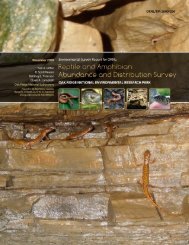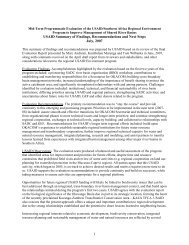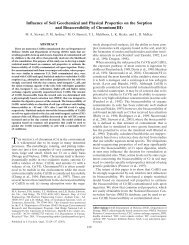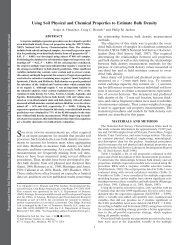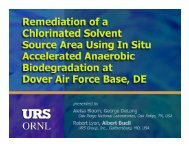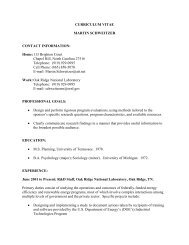oak ridge reservation physical characteristics and natural resources
oak ridge reservation physical characteristics and natural resources
oak ridge reservation physical characteristics and natural resources
You also want an ePaper? Increase the reach of your titles
YUMPU automatically turns print PDFs into web optimized ePapers that Google loves.
Chestnut Ridge, north of ORNL, near the Spallation Neutron Source site. At the ORNL site, the creek<br />
flows east along the southern boundary of the developed area <strong>and</strong> then southwesterly through a gap in<br />
Haw Ridge to the western portion of Melton Valley, where it forms a confluence with Melton Branch.<br />
The waters of White Oak Creek enter White Oak Lake, which is an impoundment formed by White<br />
Oak Dam. Water flowing over White Oak Dam enters the Clinch River after passing through the<br />
White Oak Creek embayment area.<br />
Water levels in the Clinch River are regulated by the Tennessee Valley Authority (TVA), <strong>and</strong><br />
fluctuations in the river can have an effect on streams draining the ORR. Most of the ORR is located<br />
above the probable maximum flood elevation along the Clinch River.<br />
6.1 GROUNDWATER HYDROLOGY<br />
6. SUBSURFACE HYDROLOGY<br />
A portion of the rainwater that falls on the l<strong>and</strong> surface accumulates as groundwater by<br />
infiltrating into the subsurface. The accumulation of groundwater in pore spaces of sediments <strong>and</strong><br />
bedrock creates sources of usable water; the water flows in response to external forces. Groundwater<br />
eventually reappears at the surface in springs, swamps, stream <strong>and</strong> river beds, <strong>and</strong> pumped wells.<br />
Thus, groundwater is a reservoir for which the primary input is recharge from infiltrating rainwater,<br />
<strong>and</strong> the output is discharged to springs, swamps, rivers, streams, <strong>and</strong> wells.<br />
Groundwater on the ORR occurs both in the unsaturated zone as transient, shallow subsurface<br />
storm flow <strong>and</strong> within the deeper saturated zone. An unsaturated zone of variable thickness separates<br />
the storm-flow zone <strong>and</strong> water table. Adjacent to surface water features or in valley floors, the water<br />
table is found at shallow depths, <strong>and</strong> the unsaturated zone is thin. Along the <strong>ridge</strong> tops or near other<br />
high topographic areas, the unsaturated zone is thick, <strong>and</strong> the water table often lies at considerable<br />
depth (49 to 164 ft [15 to 50 m] deep). In low-lying areas in which the water table occurs near the<br />
surface, the storm-flow <strong>and</strong> saturated zones are indistinguishable. Figure 7 is a generalized schematic<br />
showing the relationship between the streamflow zone, water table, <strong>and</strong> unsaturated (vadose) <strong>and</strong><br />
saturated (phreatic) zones.<br />
Fig. 7. Relationship between stormflow zone, water table, <strong>and</strong> unsaturated <strong>and</strong> saturated zones.<br />
13




